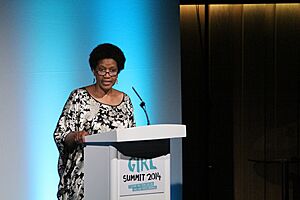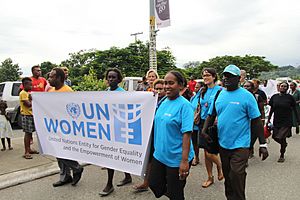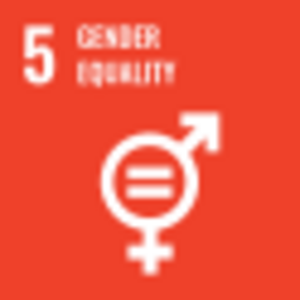UN Women facts for kids
 |
|
| Formation | 2 July 2010 |
|---|---|
| Type | UN entity |
| Headquarters | New York City, United States |
|
Official languages
|
6
English
French Spanish Chinese Arabic Russian |
|
Head
|
Sima Sami Bahous |
UN Women is a special part of the United Nations. Its main job is to work for gender equality. This means making sure everyone, no matter their gender, has the same opportunities. It also helps women and girls feel strong and capable. UN Women stands up for their rights. It focuses on important issues. These include making sure women and girls are safe and treated fairly.
UN Women started working in 2011. It was created by combining several older UN groups. These groups included the UN Development Fund for Women (UNIFEM). The organization has a special board that helps guide its work. Michelle Bachelet, a former President of Chile, was its first leader. Today, Sima Sami Bahous from Jordan is the executive director. UN Women is part of the UN Development Group.
Contents
How UN Women Started
Why UN Women Was Created
For a long time, many people at the United Nations wanted a stronger group. This group would focus only on gender equality and women's rights. They believed a new agency could make a bigger difference. It would help all parts of the UN work better together.
In 2010, the UN Secretary-General, Ban Ki-moon, suggested a plan. He said the new agency would need money to operate. It would also need funds to help countries with their programs. This plan was a big step forward.
The Official Launch of UN Women
After many talks, UN member countries agreed. On July 2, 2010, they voted to create UN Women. It brought together four different UN groups. These groups had all worked on women's issues before.
Secretary-General Ban Ki-moon was very happy. He said UN Women would greatly improve the UN's efforts. It would help promote equality and fight discrimination worldwide.
On September 14, 2010, Michelle Bachelet was chosen to lead UN Women. Many countries supported her. World leaders praised the new organization. They believed it would truly help to empower women.
How UN Women Works
Leadership and Structure
UN Women is led by an Under-Secretary-General. This person is chosen by the Secretary-General. They serve for four years and can be re-appointed.
The organization has a special way of making decisions. It has different levels of groups that guide its work. The General Assembly and the Economic and Social Council are part of this. The Commission on the Status of Women also helps set the rules.
The Executive Board
UN Women has an executive board. This board helps make decisions about its daily work. It has 41 members. These members are chosen by the Economic and Social Council. They serve for three years.
The members come from different regions of the world:
- Ten from African countries.
- Ten from Asian countries.
- Four from Eastern European countries.
- Six from Latin American and Caribbean countries.
- Five from Western European and other countries.
- Six from countries that give a lot of money to UN Women.
Sima Sami Bahous is the executive director of UN Women. The executive board members for 2020 included:
- Africa: Angola, Burundi, Democratic Republic of Congo, Equatorial Guinea, Ghana, Kenya, Madagascar, Morocco, Nigeria, Sierra Leone.
- Asia-Pacific: Bangladesh, China, India, Indonesia, Japan, Kazakhstan, Lebanon, Mongolia, Nepal, Republic of Korea, Saudi Arabia.
- Eastern Europe: Georgia, Hungary, Lithuania, Russia.
- Latin America and the Caribbean: Argentina, Brazil, Chile, Colombia, Cuba, Mexico.
- Western Europe and other States: Belgium, Canada, Germany, New Zealand, Switzerland.
- Contributing countries: Finland, Senegal, Sweden, Turkey, United Kingdom, United States.
Funding UN Women's Work
The money for UN Women's main operations comes from the UN's regular budget. This budget is approved by the General Assembly. Money for specific projects and activities comes from donations. These donations are approved by UN Women's executive board.
What UN Women Does
Main Areas of Work
UN Women's job is to combine the work of the groups it replaced. It also leads and coordinates the UN's efforts. This ensures the whole UN system works towards gender equality. UN Women wants to improve, not replace, what other UN groups do. Groups like UNICEF and UNDP still work on gender equality in their own areas.
UN Women follows the rules of the UN Charter. It also follows the Beijing Declaration and Platform for Action. This important document lists 12 key areas of concern for women.

UN Women focuses on several key areas:
- Helping women become leaders and take part in politics.
- Supporting women to become financially independent.
- Working to end harm against women.
- Providing help during emergencies.
- Promoting peace and safety.
- Helping governments plan for equality.
- Working towards the 2030 Agenda for Sustainable Development.
- Addressing issues related to HIV and AIDS.
In 2013, UN Women ran an ad campaign. It showed how common unfair ideas about women are. The ads used real internet searches to highlight this problem. A similar campaign also raised awareness for gay rights. UN Women supports the rights of LGBTIQ people. It also believes in intersectional feminism. This means understanding how different parts of a person's identity can affect their experiences.
Also in 2013, UN Women created a special database. It looks at country constitutions through a gender lens. This database helps people see how women's rights are protected or denied worldwide. It is updated every year. It helps activists work for women's rights and equality.
UN Women helps organize International Women's Day events. It also coordinates the Commission on the Status of Women.
The year 2015 was important for UN Women. It marked 20 years since the Beijing Declaration. Global leaders met to see how much progress had been made. UN Women played a big part in these meetings. They helped make sure gender equality was funded. They also helped create the new post-2015 development agenda. This plan includes a goal just for gender equality. It also makes sure equality is part of all 17 goals.
Key Goals of UN Women
UN Women has clear goals:
- To help groups like the Commission on the Status of Women create policies and global rules.
- To help UN member countries put these rules into action.
- To make sure the UN system itself is responsible for its promises on gender equality. This includes checking progress regularly.
See also
 In Spanish: ONU Mujeres para niños
In Spanish: ONU Mujeres para niños
- UN Women Goodwill Ambassador
- United Nations:
- Special measures for gender equality in the United Nations (UN)
- Convention on the Elimination of All Forms of Discrimination Against Women (CEDAW)
- Declaration on the Elimination of Discrimination against Women
- Declaration on the Elimination of Violence Against Women
- EGM: prevention of violence against women and girls
- Global Implementation Plan to End Violence against Women and Girls
- HeForShe
- NGO Committee on the Status of Women, New York (NGO CSW/NY)
- United Nations Development Fund for Women (UNIFEM)
- United Nations Security Council Resolution 1325 (UNSRC 1325)
- Convention on preventing and combating violence against women and domestic violence (Istanbul Convention)
- Gender Equality Architecture Reform (GEAR)



